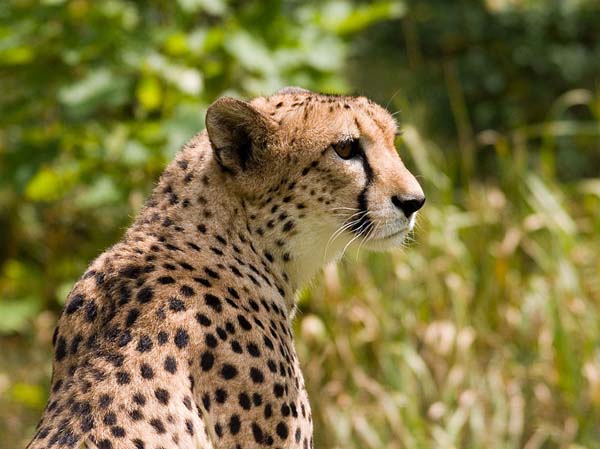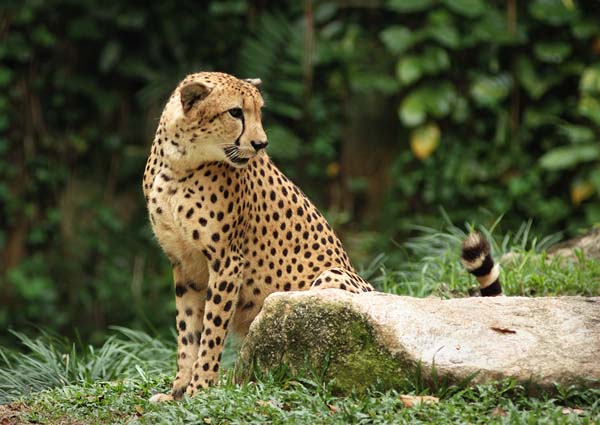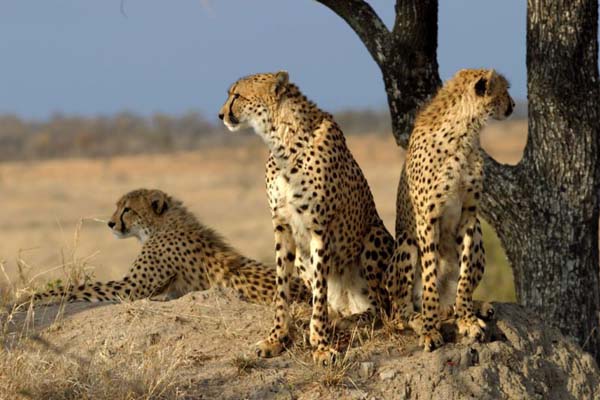
Cheetah (Acinonyx jubatus)
 Cheetah in Herberstein zoo near Stubenberg, Styria, Austria, Europe Photograph by Marion Schneider & Christoph Aistleitner. License: Public Domain. |
Description
The Cheetah is pale tawny brown or grayish white above with oval black spots about 2cm - 4cm in diameter. The underside is paler, sometimes white. Some individuals have a blotched pattern, but this is rare. The coat is fairly coarse with slightly longer hair on the back of the neck. The end of the tail has four to six black rings, with a bushy white tuft at the tip of the tail. The tail ring pattern is unique on each cheetah and can be used to identify individual animals. The head is relatively small with short ears. There is a black line cheetah has a small head with short ears, high set eyes and a black line from the inside corner of each eye to the mouth. The cheetah has a sleek agile body with long legs. The cheetah is the fastest land mammal with a top speed of an incredible 112 km/h (but more usually in sprints of up to 80km/h). It can maintain top speed for about 275m. Cheetahs have hard paws to help them run faster. The claws are only semi-retractable to help provide traction during running. The long tail helps to balance the body during quick turning.
SizeHeight: 67cm - 94cm at the shoulder. Head and body length: 121cm - 150cm. Tail length: 70cm - 81cm. Males are slightly larger than females.
HabitatThe Cheetah prefers habitat with tall grass and shrubs and elevated lookouts to watch prey from.
FoodThe cheetah is a carnivore and eats mainly gazelles. Also eats impalas, birds, rabbits, young warthogs, kudu, hartebeest, oryx, roan, sable. They hunt in early morning and late afternoon. The cheetah stalks its prey to get within 50m before sprinting to attack. Each sprint lasts for about 20 seconds and sometimes for about a minute. Most chases are unsuccessful, but when contact is made, the cheetah knocks down its prey by charging it before biting the throat to strangle it.
BreedingCheetahs breed throughout the year. One to eight (usually three to five) cubs are born after a gestation period of 90 to 95 days. Cubs are about 30cm long at birth and gray in colour. They are gray in color with longer hair along their back. The mother leaves the cubs alone to hunt, and many cubs are killed by predators such as lions. Cubs start to follow their mother at 6 weeks of age and are weaned at three to six months and remain with their mother for 13 to 20 months.
RangeThe cheetah is found in Algeria, Angola, Benin, Botswana, Burkina Faso, Cameroon, Central African Republic, Chad, Democratic Republic of Congo, Egypt, Eritrea, Ethiopia, Malawi, Mali, Mauritania, Mozambique, Namibia, Niger, Nigeria, Somalia, South Africa, Sudan, Swaziland, Tanzania, Togo, Zambia, Zimbabwe.
Conservation StatusThe conservation status in the IUCN Red List of Threatened Animals is "vulnerable".
Classification
|
 Cheetah Photograph by schani. Some rights reserved. |
 Cheetah in the Singapore Zoo Photograph by PlasticTV. Some rights reserved. |
 A group of Cheetahs (Acinonyx jubatus) at Sabi Sands Game Reserve, South Africa. Photograph by James Temple. Some rights reserved. |
|
Home | References | Privacy Policy | Contact Us Copyright © 2008-2013 Wotcat.com |